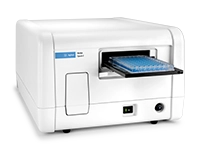Why so many plate readers in the same lab?
We use a technique for metabolic engineering called growth-coupled selection. Here, we create mutant strains that cannot grow until the pathway of interest is cloned inside the cell to complement growth. In this way, bacterial growth profiles become the readout of how well the pathway can support the metabolic flux (= do its job). This technique is now central in our laboratory, and many people use it. Therefore, this requires a lot of plates. The plate readers are perfect for this purpose, as you start the experiment, and the kinetic measurement provides you with the growth profile without the need of manually measuring OD over multiple hours/days.
Innovative solution when space is limited :
We have 1 PC connected to each reader. We have two screens, meaning that each screen is connected to 6 PC using a switch.



